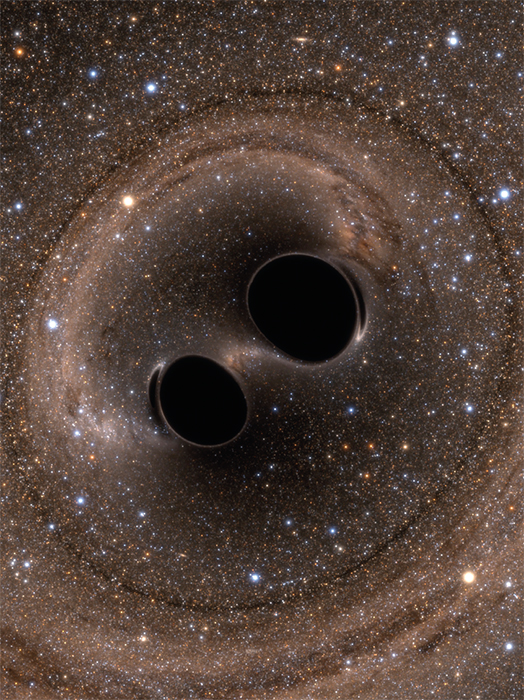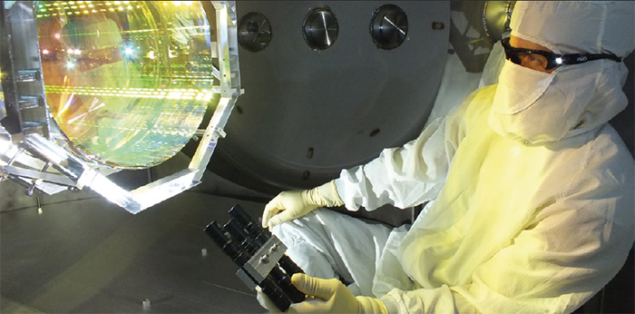Twenty years of hard work with a strong belief that the endeavour would lead to a historic breakthrough.

Image credit: The SXS (Simulating eXtreme Spacetimes) Project.
On 11 February, the Laser Interferometer Gravitational-Wave Observatory (LIGO) and Virgo collaborations published a historic paper in which they showed a gravitational signal emitted by the merger of two black holes. The signal has been observed with 5σ significance and is the first direct observation of gravitational waves.
This result comes after 20 years of hard work by a large collaboration of scientists operating the two LIGO observatories in the US. Barry Barish, Linde professor of physics, emeritus, at the California Institute of Technology and former director of the Global Design Effort for the International Linear Collider (ILC), led the LIGO endeavour from 1994 to 2005. On the day of the official announcement to the scientific community and the public, Barish was at CERN to give a landmark seminar that captivated the whole audience gathered in the packed Main Auditorium.
The CERN Courier had the unique opportunity to interview Barish just after the announcement.
Professor Barish, this achievement comes after 20 years of hard work, uncertainties and challenges. This is what research is all about, but what was the greatest challenge you had to overcome during this long period?
It really was to do anything that takes 20 years and still be supported and have the energy to reach completion. We started long before that, but the project itself started in 1994. LIGO is an incredible technical achievement. The idea that you can take on high risk in such a scientific endeavour requires a lot of support, diligence and perseverance. In 1994, we convinced the US National Science Foundation to fund the project, which became the biggest programme to be funded. After that, it took us 10 years to build it and to make it work well, plus 10 years to improve the sensitivity and bring it to the point where we were able to detect the gravitational waves. And along the way no one had done this before.
Indeed, the experimental set-up we used to detect the gravitational signal is an enormous extrapolation from anything that was done before. As a physicist, you learn that extrapolating a factor of two can be within reach, but a factor of 10 sounds already like a dream. If you compare the first 40 m interferometer we built on the CALTECH campus with the two 4000 m interferometers we have now, you already have an idea of the enormous leap we had to make. The leap of 100 in size also involved at least that in complexity and sophistication, eventually achieving more than 10,000 times the sensitivity of the original 40 m prototype.
The two signals were perfectly consistent, and this gave us total trust in our data.
The experimental confirmation of the existence of the gravitational waves could have a profound impact on the future of astrophysics and gravitational physics. What do you think are the most important consequences of the discovery?
The discovery opens two new areas of research for physics. One is on the general-relativity theory itself. Gravitational waves are a powerful way of testing the heart of the theory by investigating the strong-field realm of gravitational physics. Even with just this first event – the merging of two black holes – we have created a true laboratory where you can study all of this, and understanding general relativity at an absolutely fundamental level is now opening up.
The second huge consequence of the discovery is that we can now look at the universe with a completely new “telescope”. So far, we have used and built all kinds of telescopes: infrared, ultraviolet, radio, optical… And the idea of recent years has been to look at the same things in different bandwidths.

Image credit: Matt Heintze/Caltech/MIT/LIGO Lab.
However, no such previous instrument could have seen what we saw with the LIGO interferometers. Nature has been so generous with us that the very first event we have seen is new astrophysics, as astronomers had never seen stellar black holes of these masses. With just the first glimpse at the universe with gravitational waves, we now know that they exist in pairs and that they can merge. This is all new astrophysics. When we designed LIGO, we thought that the first thing we would see gravitational waves emitted by was neutron stars. It would still be a huge discovery, but it would not be new astrophysical information. We have been really lucky.
Over the next century, this field will provide a completely new way of doing an incredible amount of new science. And somehow we had a glimpse of that with the first single event.
What were your feelings upon seeing the event on your screen?
We initially thought that it could be some instrumental crazy thing. We had to worry about many possible instrumental glitches, including whether someone had purposely injected a fake event into our data stream. To carefully check the origin of the signal, we tracked back the formation of the event data from the two interferometers, and we could see that the signal was recorded within seven milliseconds – exactly the time we expect for the same event to appear on the second interferometer. The two signals were perfectly consistent, and this gave us total trust in our data.
I must admit that I was personally worried as, in physics, it is always very dangerous to claim anything with only one event. However, we proceeded to perform the analysis in the most rigorous way and, indeed, we followed the normal publication path, namely the submission of the paper to the referees. They confirmed that what we submitted was scientifically well-justified. In this way, we had the green light to announcing the discovery to the public.
At the seminar you were welcomed very warmly by the audience. It was a great honour for the CERN audience to have you give the talk in person, just after your colleagues’ announcement in the US. What are you bringing back from this experience?
I was very happy to be presenting this important achievement in the temple of science. The thing that made me feel that we made the case well was that people were interested in what we have done and are doing. In the packed audience, nobody seemed to question our methodology, analysis or the validity of our result. We have one single event, but this was good enough to convince me and also my colleagues that it was a true discovery. I enjoyed receiving all of the science questions from the audience – it was really a great moment for me.
• The LIGO and Virgo collaborations are currently working on analysing the rest of the data from the run that ended on 12 January. New information is expected to be published in the coming months. In the meantime, the discovery event is available in open data (see https://losc.ligo.org) for anyone who wants to analyse it.








